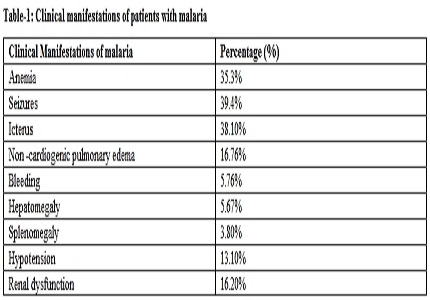Clinical profile and outcome of cerebral malaria in pediatric cases at a tertiary Care Hospital
Abstract
Background: Cerebral malaria (CM) is a potentially fatal condition encountered in all age groups and if not treated timely can cause mortality.
Objective: to evaluate the clinical features of cerebral malaria in children at a tertiary care Hospital of Telangana.
Methods: This was a prospective study carried out from January 2013 to December 2014 at a tertiary care hospital of Telangana. Clinical profile, treatment and outcome of all the children diagnosed with CM aged between 5 months to 12 years were assessed.
Results: There were a total of 65 patients with CM of which 40 (74.7%) of them were girls and 20 were boys (25%). P. falciparum was the main infecting species in both uncomplicated malaria and severe malaria cases. The clinical features noted were seizure (39.62%), anemia (84.9%), icterus (16.98%), hypotension (13.2%), bleeding (3.7%), hepatomegaly (5.66%), splenomegaly (5.66%), pulmonary edema (16.98%) and renal dysfunction (37.36%). Treatment received included artesunin compounds or quinine. Complete recovery was achieved in 53 (81%) of them. Three (6.1%) of them died.
Conclusion: CM considered being a fatal disease has shown remarkable improvement in the outcome with the wide availability of artesunin and quinine components. The key to management is early diagnosis and initiation of treatment based on a high index of suspicion.
Downloads
References
2. Malaria situation in India (2009-2013). In: National Vector Borne Disease Control Programme. Ministry of Health & Family Welfare, Delhi.
3. Kaushik JS, Gomber S, Dewan P: Clinical and epidemiological profile of severe malaria in children from Delhi, India. J Health Popul Nutr. 2012 Mar;30(1):113-6. [PubMed]
4. Sarkar D, Ray S, Saha M, Chakraborty A, Talukdar A. Clinico‑laboratory profile of severe Plasmodium vivax malaria in a tertiary care centre in Kolkata. Trop Parasitol. 2013 Jan;3(1):53-7. doi: 10.4103/2229-5070.113912.
5. Nadkar MY, Huchche AM, Singh R, Pazare AR. Clinical profile of severe Plasmodium vivax malaria in a tertiary care centre in Mumbai from June .J Assoc Physicians India. 2012 Oct;60:11-3.
6. CDC‑Malaria‑About Malaria‑Disease. (Monograph on the Internet). Available from: http://www.cdc.gov/malaria/ about/disease.html. [Last cited on 2015 Aug 23].
7. World Health Organization. Guidelines for the treatment of Malaria. Second Edition. (Monograph on the Internet). Available from: http://www.who.int/malaria/publications/ atoz/9789241547925/en/index.html? [Last cited on 2016Feb 4].
8. Wasnik PN, Manohar TP, Humaney NR, Salkar HR. Study of clinical profile of falciparum malaria in a tertiary referral centre in Central India. J Assoc Physicians India 2012;60:33‑6. [PubMed]
9. Camara B, Diagne-Gueye NR, Faye PM, Fall ML, Ndiaye JL, Ba M, Sow HD. [Malaria severity criteria and prognostic factors among children in Dakar]. Med Mal Infect. 2011 Feb;41(2):63-7. [PubMed]
10. Patil V. Complicated falciparum Malaria in western Maharashtra. Trop Parasitol. 2012 Jan;2(1):49-54. doi: 10.4103/2229-5070.97240. [PubMed]
11. Ronald LA, Kenny SL, Klinkenberg E, Akoto AO, Boakye I, Barnish G, et al. Malaria and anaemia among children in two communities of Kumasi, Ghana: A cross‑sectional survey. Malar J 2006;5:105. [PubMed]
12. Mishra SK, Mohanty S, Satpathy SK, Mohapatra DN. Cerebral malaria in adults – A description of 526 cases admitted to Ispat General Hospital in Rourkela, India. Ann Trop Med Parasitol. 2007 Apr;101(3):187-93. [PubMed]
13. Guidelines for the treatment of malaria‑libdoc.who. int‑World. (Monograph on Internet). Available from http://www.whqlibdoc.who.int/publications/2010/9789241547925_ eng. [Last cited on 2016Feb 24].
14. Dondorp A, Nosten F, Stepniewska K, Day N, White N, South East Asian Quinine Artesunate Malaria Trial (SEAQUAMAT) Group. Artesunate versus quinine for treatment of severe falciparum malaria: A randomised trial. Lancet 2005;366:717‑25. [PubMed]
15. Lon C, Timmermans A, Buathong N, Nou S, Se Y, Sitthy N, et al. Severe malaria in Battambang Referral Hospital, an area of multidrug resistance in Western‑Cambodia: A retrospective analysis of cases from 2006‑2009. Malar J 2013;12:217.
16. Murphy SC, Breman JG. Gaps in the childhood malaria burden in Africa: Cerebral malaria, neurological sequelae, anemia, respiratory distress, hypoglycemia, and complications of pregnancy. Am J Trop Med Hyg 2001;64:57‑67.
17. Oduro AR, Koram KA, Rogers W, Atuguba F, Ansah P, Anyorigiya T, Ansah A, Anto F, Mensah N, Hodgson A, Nkrumah F. Severe falciparum malaria in young children of the Kassena-Nankana district of northern Ghana. Malar J. 2007 Jul 27;6:96. [PubMed]

Copyright (c) 2017 Author (s). Published by Siddharth Health Research and Social Welfare Society

This work is licensed under a Creative Commons Attribution 4.0 International License.


 OAI - Open Archives Initiative
OAI - Open Archives Initiative


